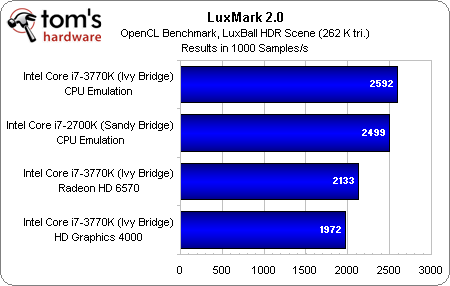Intel Core i7-3770K Review: A Small Step Up For Ivy Bridge
HD Graphics 4000: Native Compute Support
Ivy Bridge also includes the groundwork necessary to support OpenCL and DirectCompute 5.0.
But wait, didn’t Intel already release a driver for Sandy Bridge that enabled compute functionality? It did. HD Graphics 3000/2000 doesn’t actually support these APIs, though. They’re emulated and executed on the host processor, which is why compute workloads peg Sandy Bridge-based chips at 100% utilization.
HD Graphics 4000, on the other hand, supports FP32/FP64 under DirectCompute and FP32 in OpenCL. Intel currently lacks Khronos certification for ARB_gpu_shader_fp64, so it’s not enabled.
It’s immediately apparent how much faster native FP32 runs on HD Graphics 4000 compared to Sandy Bridge’s IA cores emulating OpenCL support. Because Sandra has to emulate FP64 through FP32, native double-precision performance looks a lot lower. However, that’s still GPU-only.
With Nvidia’s Kepler architecture capping FP64 at 1/24 single-precision performance, it’ll be interesting to see how HD Graphics 4000 compares to derivative discrete GPUs from Nvidia (particularly if Intel adds its own OpenCL FP64 extension).
Again, HD Graphics 3000 lacks native OpenCL support, so it’s missing from this chart. However, we see that Intel’s quad-core processors emulate OpenCL very well (albeit at full processor load and higher power consumption).
The discrete Radeon HD 6570 trails both Ivy and Sandy Bridge architectures, and is turn followed by HD Graphics 4000 with native OpenCL support. But instead of the IA cores completely tied up, CPU utilization sits at 0%, while power hovers 50 W lower. As far as performance per watt goes, that’s pretty darned impressive.
Get Tom's Hardware's best news and in-depth reviews, straight to your inbox.
Current page: HD Graphics 4000: Native Compute Support
Prev Page HD Graphics 4000: Performance In Skyrim And WoW Next Page Quick Sync: A Secret Weapon, Refined-
tecmo34 Nice Review Chris...Reply
Looking forward to the further information coming out this week on Ivy Bridge, as I was initially planning on buying Ivy Bridge, but now I might turn to Sandy Bridge-E -
jaquith Great and long waited review - Thanks Chris!Reply
Temps as expected are high on the IB, but better than early ES which is very good.
Those with their SB or SB-E (K/X) should be feeling good about now ;) -
xtremexx saw this just pop up on google, posted 1 min ago, anyway im probably going to update i have a core i3 2100 so this is pretty good.Reply -
ojas it's heeearrree!!!!! lol i though intel wan't launching it, been scouring the web for an hour for some mention.Reply
Now, time to read the review. :D -
zanny It gets higher temps at lower frequencies? What the hell did Intel break?Reply
I really wish they would introduce a gaming platform between their stupidly overpriced x79esque server platform and the integrated graphics chips they are pushing mainstream. 50% more transistors should be 30% or so more performance or a much smaller chip, but gamers get nothing out of Ivy Bridge. -
JAYDEEJOHN It makes sense Intel is making this its quickest ramp ever, as they see ARM on the horizon in today's changing market.Reply
They're using their process to get to places they'll need to get to in the future -
verbalizer OK after reading most of the review and definitely studying the charts;Reply
I have a few things on my mind.
1.) AMD - C'mon and get it together, you need to do better...2.) imagine if Intel made an i7-2660K or something like the i5-2550K they have now.
3.) SB-E is not for gaming (too highly priced...) compared to i7 or i5 Sandy Bridge
4.) Ivy Bridge runs hot.......
5.) IB average 3.7% faster than i7 SB and only 16% over i5 SB = not worth it
6.) AMD - C'mon and get it together, you need to do better...
(moderator edit..) -
Pezcore27 Good review.Reply
To me it shows 2 main things. 1) that Ivy didn't improve on Sandy Bridge as much as Intel was hoping it would, and 2) just how far behind AMD actually is... -
tmk221 It's a shame that this chip is marginally faster than 2700k. I guess it's all AMD fault. there is simply no pressure on Intel. Otherwise they would already moved to 8, 6, and 4 cores processors. Especially now when they have 4 cores under 77W.Reply
Yea yea I know most apps won't use 8 cores, but that's only because there was no 8 cores processors in past, not the other way around


